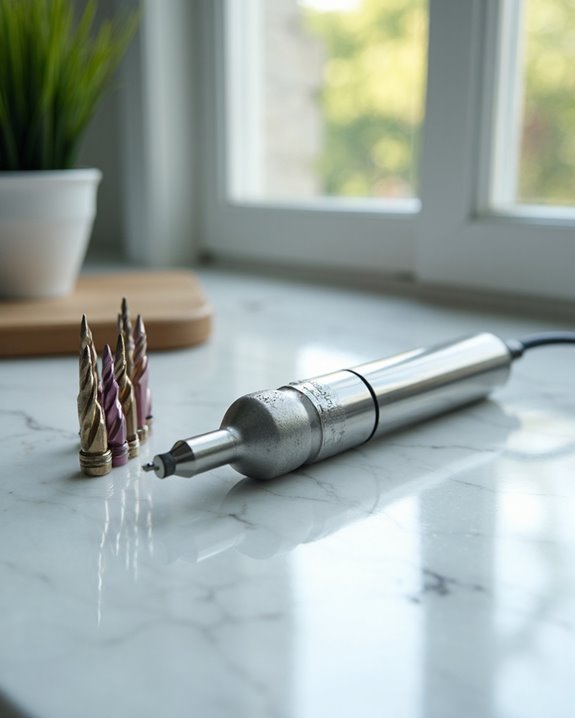Nails can hold in drywall but with significant limitations. Standard nails support only 10 pounds maximum, while angled nails driven into studs may hold up to 20 pounds. They frequently loosen over time, causing unsightly “nail pops” and potential wall damage. For lightweight decorative items, ringed or cement-coated nails provide adequate grip, but heavier objects require screws or specialized anchors which offer 5-25 pounds (expansion anchors) to 100 pounds (toggle bolts) of superior holding capacity.
Key Takeaways
- Nails can hold in drywall but support only 10 pounds maximum on their own, or up to 20 pounds when angled into studs.
- Ringed or barbed shank nails offer better holding power than smooth nails by creating more friction with drywall material.
- Screws are superior to nails for drywall, supporting up to 100 pounds versus a nail’s 20-pound maximum capacity.
- Nails tend to loosen over time causing “pops” that damage drywall, while screws maintain consistent holding power.
- For heavier items, specialized anchors like toggle bolts or molly bolts are more reliable than standard nails in drywall.
Understanding the Basics of Drywall Construction
The foundation of any drywall project begins with understanding how gypsum panels attach to the underlying framework of a home. In standard construction, these panels connect to vertical wall studs typically positioned 16 to 24 inches apart, creating the structural support system essential for wall integrity. A stud finder helps locate these critical support points where fasteners will provide maximum holding power. While historically nails were favored for their speed and affordability, modern contractors increasingly prefer screws to prevent nail pops and guarantee superior weight capacity. For proper installation, professionals select fasteners based on drywall thickness: 1/2-inch panels require 1-1/4 or 1-3/8-inch screws, while 5/8-inch panels need 1-3/8 or 1-5/8-inch screws. When additional holding strength is necessary, specialized drywall anchors like molly bolts provide reinforcement, often requiring a pilot hole for maximum performance.
Types of Nails Used for Drywall Applications

When selecting fasteners for drywall installation, contractors often consider various nail types designed specifically for gypsum board applications. Ringed or barbed shank drywall nails provide greater holding power when securing panels to wood studs, making them suitable for wall installations but less ideal for ceiling joists. Cement-coated varieties feature a smooth shank with resin coating that enhances grip strength, reducing the likelihood of the nail backing out over time.
Cupped-head or flat head designs allow for proper countersinking into the drywall surface, creating a smoother finish that requires minimal spackling. While drywall screws have gained popularity for their superior holding strength, contractors may still use nails for budget-conscious projects where cost efficiency is paramount. For heavier installations requiring robust support, specialized types of anchors like toggle bolts provide substantially more holding capacity than standard nails.
Weight Capacity: What Nails Can Actually Support in Drywall
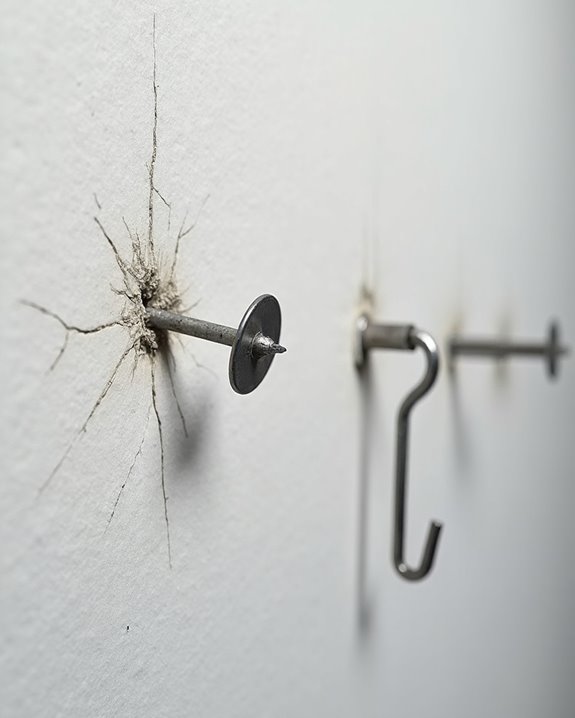
Weight capacity represents a significant limitation when using nails in drywall, as standard nail installations provide minimal holding power in this relatively soft material. Drywall alone typically supports very little weight when using conventional nails, with a maximum recommended capacity of just 10 pounds per nail to prevent failure. For anything exceeding this threshold, homeowners should choose screws or drywall plugs instead, as these provide greater surface area and superior grip within the gypsum material.
When attempting to hang anything of substantial weight, it’s important to recognize that nails are not capable of holding much weight without additional support structures. Most professional installers require a pilot hole and use screws for medium to heavy items, reserving nails exclusively for decorative elements under 10 pounds.
Nails vs. Screws: Comparing Holding Power in Drywall

How do nails truly compare to screws when securing items to drywall? The evidence clearly demonstrates screws’ superior holding power, with a #4 screw in a stud supporting up to 100 pounds compared to a nail’s mere 20-pound capacity. This significant difference makes screws the preferred fasteners for drywall installations requiring durability and stability.
Screws effectively penetrate studs with their self-starting tips, maintaining consistent holding power over time, while nails tend to loosen gradually, causing visible pops and surface damage. Building codes recognize this disparity, typically requiring fewer screws than nails to achieve equivalent stability in drywall applications. Although nails remain more economical for lightweight applications, their limited holding capacity makes them unsuitable for substantial loads, where screws or expansion anchors provide necessary long-term reliability.
When Nails Work Best for Drywall Projects
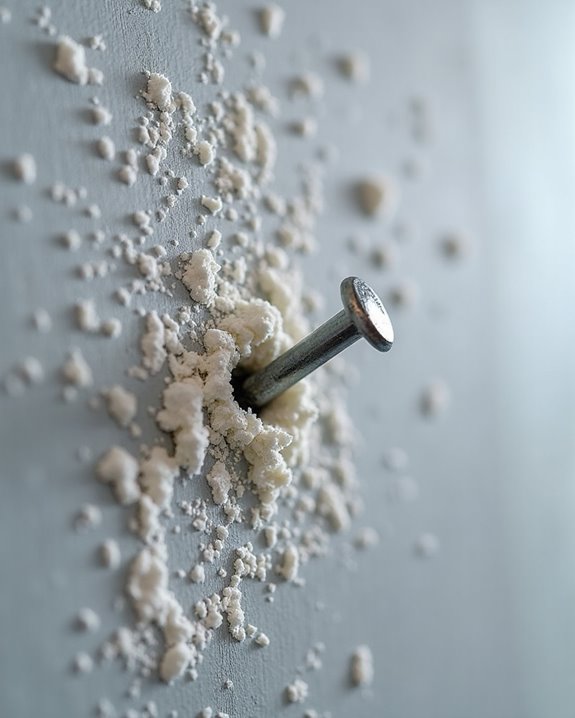
Despite their lower overall holding capacity, nails remain valuable tools in specific drywall applications where their unique properties offer practical advantages. When attaching drywall to wood studs in wall installations, it’s important to use ringed or barbed shank nails, which can reliably return to one stable position and hold up to 20 pounds when driven at a 45-degree angle. Drywall wall projects benefit when contractors take into account cost efficiency, as nails are more economical than using a drywall screw gun setup.
For perimeter fastening, make sure to space nails every 8 inches on wood framing, and consider double-nailing panels to minimize nail pops. According to Home Improvement Stack Exchanges, cement-coated nails are particularly effective for non-structural, lightweight applications where their resin coating enhances holding power.
Proper Nail Installation Techniques for Maximum Strength
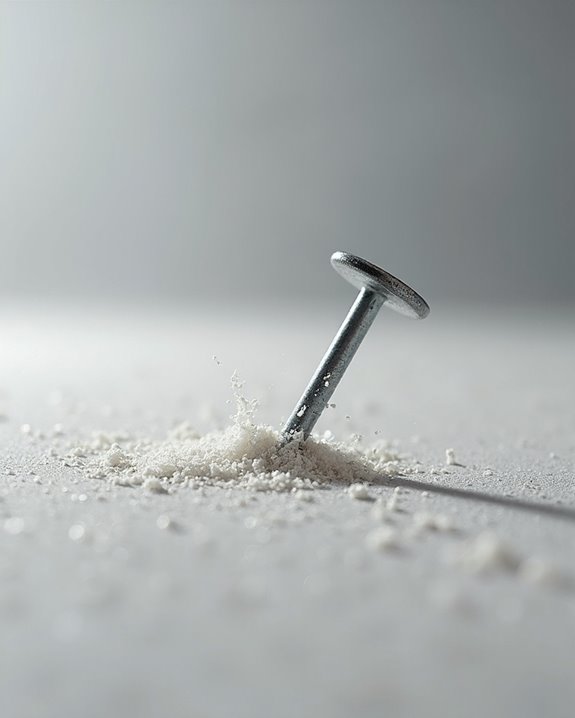
The effectiveness of drywall nails depends greatly on proper installation techniques that maximize their holding power. Home improvement professionals recommend using drywall nails with ringed or barbed shanks, which are thicker than expansion anchors and provide superior grip in the material. When hanging items, driving nails at a critical point—a 45-degree upward angle into studs—ensures a 1.5-inch nail can support up to 20 pounds.
Tips on writing great installations include spacing ring nails every 8 inches along perimeters to distribute weight evenly. The source and reason for double-nailing panels is to minimize nail pops in movement-prone areas. Improvement Stack Exchange’s artificial separation between nails creates redundancy that reinforces holding power. Statements based on opinion may vary, but experts are sure to answer that proper angle placement at right angles preserves drywall integrity.
Alternative Fastening Solutions for Heavier Items
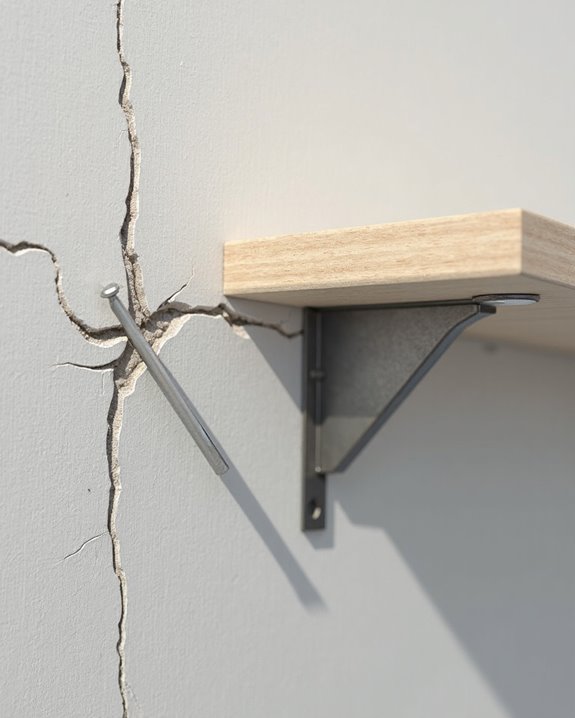
While standard drywall nails serve adequately for lightweight decorations, homeowners requiring support for items exceeding 10 pounds must consider alternative fastening solutions. Expansion anchors provide reliable support for objects weighing 5 to 25 pounds by distributing pressure when tightened, while threaded anchors offer enhanced capacity of 25 to 75 pounds without requiring pilot holes.
For substantially heavier items, toggle bolts represent an excellent option, supporting up to 100 pounds through their spring-loaded mechanism that expands behind the drywall. Sleeve anchors, including molly bolts, provide intermediate support of 25 to 50 pounds by gripping both sides of the drywall surface. The most secure method, however, involves mounting directly to wall studs using screws that penetrate at least 1 inch into the wood, creating a hold capable of supporting 100 pounds.
Frequently Asked Questions
How Do You Get Nails to Stay in Drywall?
Nail grip in drywall improves with proper wall fasteners like ringed shank nails. Secure hammering into studs at 45-degree angles enhances holding power. Drywall anchors offer additional stability, preventing slipping and increasing fastener longevity.
Is It Better to Screw or Nail Drywall?
Screw advantages include superior material strength and fastener longevity compared to nails. While nail durability varies, screws offer better cost efficiency, improved surface finish, faster installation speed, and easier removal, making them the preferred choice for drywall installation.
Can Drywall Support Human Weight?
Light as a feather, drywall lacks the structural integrity to support human weight. Its limited load-bearing capacity falls well below safety standards, posing serious hanging risks. Building codes require proper support systems for human safety concerns.
Can You Nail Into Drywall Without Studs?
Nailing into drywall without studs is possible but unreliable. Wall preparation affects success, while nail angles impact holding power. DIY advice: choose appropriate tools and consider aesthetic effects. For safety, use anchors for items exceeding 10 pounds.


